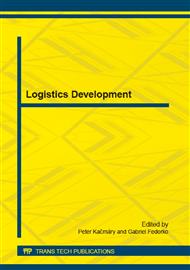[1]
The Moravian Provincial Archives Brno branch of the State District Archive in Zlín, fund Bata as, Zlin (1887 - 1948), part of the Fund: The director's office I, II, III, IV, Balance 1920-1938, Manufacturing, Accounting. (original in Czech).
Google Scholar
[2]
I. Jakubec, Czech economic development of countries in the period 1848-1992, first ed., Oeconomica, Praha, 2008. (original in Czech).
Google Scholar
[3]
B. Lehár, History of the Bata Group (1894-1945), first ed., State Political Literature Publishing House, Praha, 1960. (original in Czech).
Google Scholar
[4]
J. Geršlová, Industry and crafts production in interwar Czechoslovakia in the light of rationalization and their economic and social consequences, Národohospodářský ústav Josefa Hlávky, Praha, 2003. (original in Czech).
Google Scholar
[5]
P. L. King, J. S. King, The product wheel handbook: creating balanced flow in high-mix process operations. CRC Press, Boca Raton, (2013).
DOI: 10.1201/b14568-7
Google Scholar
[6]
P. L. King, Lean for the process industries: dealing with complexity. CRC Press, Boca Raton, (2009).
Google Scholar
[7]
Á. Paulinyi, Industrial Revolution: the origin of modern technology, first Czech ed., ISV, Praha, 2002. (original in Czech).
Google Scholar
[8]
M. P. Groover, Fundamentals of modern manufacturing: materials, processes and systems, 4th ed., J. Wiley & Sons, Hoboken, (2010).
Google Scholar
[9]
A. Zelenka, V. Preclík, Rationalization of production, first ed., ČVUT, Praha, 2004. (original in Czech).
Google Scholar
[10]
G. Tomek, V. Vávrová. Integrated management: from operational control the supply chain, fisrt ed., Grada, Praha, 2014. (original in Czech).
Google Scholar
[11]
G. Fedorko, A. Rosová, V. Molnár, The application of computer simulation in solving traffic problems in the urban traffic management in Slovakia, Theoretical and Empirical Researches in Urban Management. 9-3 (2014) 5-17.
Google Scholar
[12]
R. Németh, V. Molnár, L. Olexa, Evaluation of transport research between U. S. Steel Košice employees in an integrated transport system, International Conference on Industrial Logistics (ICIL 2014). (2014) 173-180.
Google Scholar
[13]
G. Fedorko, Z. Čujan, Optimization in modern business practice, International Conference on Industrial Logistics, (ICIL 2014). (2014) 167-175.
Google Scholar


